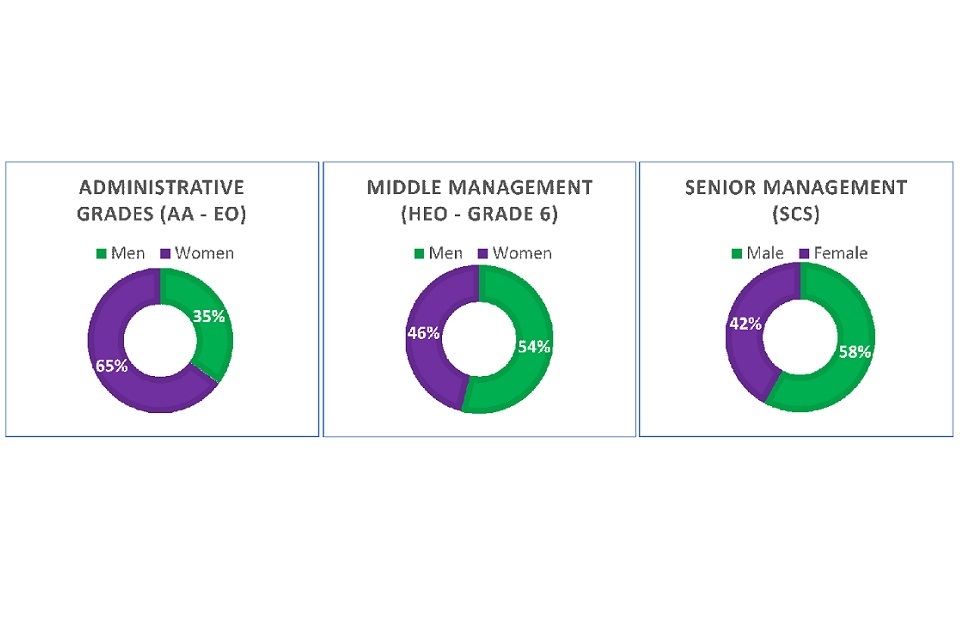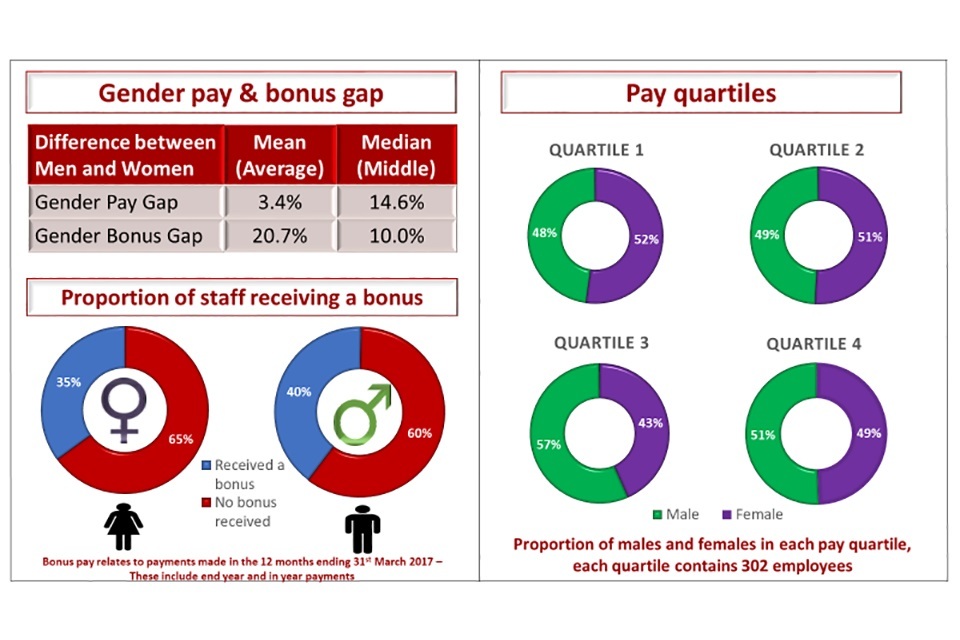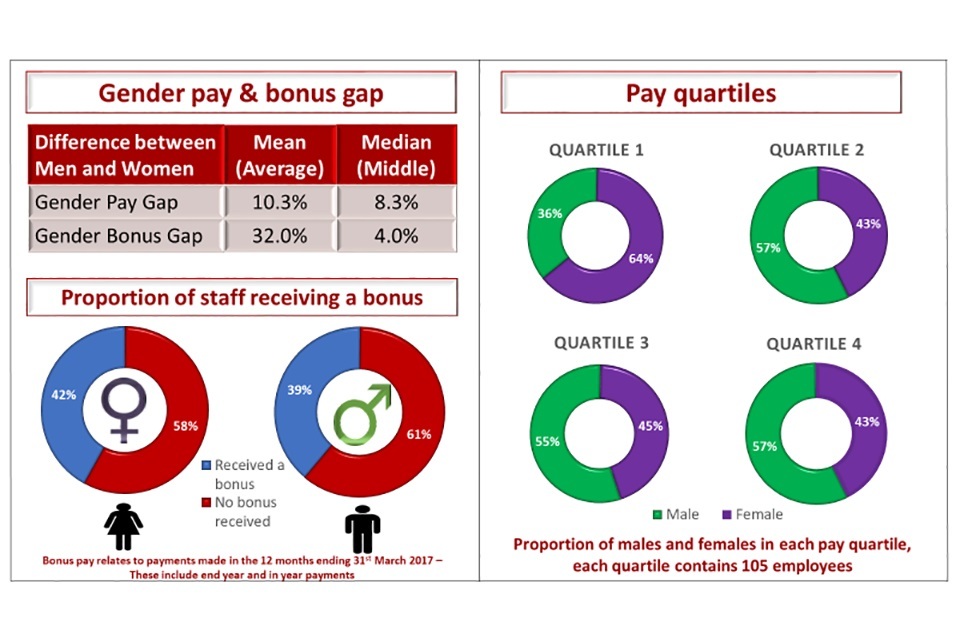Gender Pay Gap Report 2016 - 2017: HM Treasury Group
Updated 20 December 2017
1. Introduction
Earlier this year, the government introduced world-leading legislation that made it statutory for organisations with 250 or more employees to report annually on their gender pay gap. Government departments are covered by the Equality Act 2010 (Specific Duties and Public Authorities) Regulations 2017 which came into force on 31 March 2017. These regulations underpin the Public Sector Equality Duty and require the relevant organisations to publish their gender pay gap data by 30 March 2018, and then annually, including mean and median gender pay gaps; the mean and median gender bonus gaps; the proportion of men and women who received bonuses; and the proportions of male and female employees in each pay quartile.
The gender pay gap shows the difference in average pay between all men and women in the workforce. If a workforce has a particularly high gender pay gap, this can indicate there may be a number of issues to deal with, and the individual calculations may help identify what those issues are.
The gender pay gap is different from equal pay. Equal pay deals with the pay differences between men and women who carry out the same jobs, similar jobs or work of equal value. It is unlawful to pay people unequally because they are a man or a woman.
The Treasury is committed to fairness. In particular, promoting equality of opportunity for all and a culture which values differences. As an employer, we want to ensure our workforce is representative of the community it serves and attract and retain talented employees from a wide range of backgrounds and with diverse skills and experience. We regularly publish information on the wider diversity of our workforce, including in the Treasury’s annual report and accounts. The Treasury last undertook an equal pay audit in 2016.
This report includes figures for the overall Treasury group, which includes the central Department and our executive agencies - Government Internal Audit Agency, Debt Management Office and the National Infrastructure Commission. All figures in this report relate to the Treasury group unless stated otherwise.
All of the data included in this report has been calculated according to the requirements of The Equality Act 2010 (Specific Duties and Public Authorities) Regulations 2017.
HM Treasury Group

HMT
2. Gender pay gap analysis
The overall mean gender pay gap in the Treasury group, which includes the core Department and our executive agencies – Government Internal Audit Agency, Debt Management Office and the National Infrastructure Commission – is 7.1%. The Treasury groups’ median gender pay gap is 13.7% which is below the national median gender pay gap of 18.4% [footnote 1].
The pay gaps do not indicate that men and women are being paid differently for equal work, but the data below shows there is a higher proportion of women in junior grades and lower representation at senior levels, which affects the average and median pay for each gender. This has a greater impact on median pay which explains the difference between the mean and median pay gaps.

Gender pay gap analysis
HM Treasury Group
| Grade (increasing Seniority) | Number of men (% of men who work in this grade) | Number of women (% of women who work in this grade) | % Female |
|---|---|---|---|
| AA/AO | 27 (3%) | 40 (5%) | 60% |
| EO | 58 (6%) | 108 (13%) | 65% |
| HEO/SEO | 410 (45%) | 361 (44%) | 47% |
| Grade 6/7 | 354 (39%) | 267 (32%) | 43% |
| SCS (Centrally managed) | 67 (7%) | 49 (6%) | 42% |
| Total | 916 | 825 | 47% |
Female representation at different grades in the Treasury group is very similar to that in the Civil Service as a whole, where women are over-represented in the more junior grades and under-represented in the more senior grades[footnote 4].
Civil Service Wide
| Grade (increasing Seniority) | Number of men (% of men who work in this grade) | Number of women (% of women who work in this grade) | % Female |
|---|---|---|---|
| AA/AO | 62,688 (34%) | 86,861 (40%) | 58% |
| EO | 48,308 (26%) | 62,463 (29%) | 56% |
| HEO/SEO | 51,003 (27%) | 47,846 (22%) | 48% |
| Grade 6/7 | 22,566 (12%) | 18,801 (9%) | 45% |
| SCS (Centrally managed) | 2,466 (1%) | 1,771 (1%) | 42% |
| Total | 193,100 | 226,380 | 54% |
The Treasury groups’ mean bonus gender pay gap is 33.5%, the median bonus gender pay gap is 20%. This difference is because bonuses paid to Senior Civil Servant (SCS) employees are considerably higher than those paid to delegated grades (AA – Grade 6), as they are centrally set, and there is a lower proportion of women in the SCS. Women made up 42% of the SCS as at 31st March 2017, with a much higher proportion of women in junior grades - women made up 65% of the lowest three grades as at 31st March 2017.
This is even more stark in the executive agencies, where women made up 33% of the SCS and 72% of the lowest two grades as at 31st March 2017. This has resulted in a larger mean and median bonus gender pay gap.
3. Closing the gap
Below we set out the actions that the central HM Treasury Department are planning to take to close the gender pay gap. Our executive agencies also have their own separate plans to help them address their own gender pay gaps.
The Treasury is committed to minimising the gender pay gap within the organisation. We have already made improvements to our pay system to shorten pay ranges and thereby improve internal equity. We have also set out an ambitious target of achieving representation of 50% female at every grade in the organisation as part of our Diversity and Inclusion action plan. A particular emphasis has been placed on increasing the representation of women in senior level positions and we have also launched several initiatives, including improving our diversity of graduate recruitment and ensuring greater representation of women in our talent programmes, to help achieve this. Over the last two years, we have already seen the number of women increase at SCS level by 3.2%. Since 31st March 2017 50% of our Directors and Director Generals are now women.
This year, to improve the distribution of performance bonuses at the most senior levels of the organisation, the SCS pay committee included an external diversity expert, which has resulted in improved outcomes in terms of gender and part time workers and we would expect this to be reflected in our 2018 data.
Diversity Delivery Committee
The Diversity Delivery Committee brings together the Executive Management Board diversity champions, the co-chairs of the Diversity and Inclusion Board and the Director of Corporate Services to lead and oversee the delivery of the Treasury Diversity and Inclusion Action plan, which will deliver initiatives aimed at developing and retaining a diverse workforce that fully reflects the Treasury’s values. To achieve the scale of transformation needed, diversity needs to become central to every major decision the department makes and mainstreamed into everyday activity and culture of every group and team.
Women in Treasury network
The Women in Treasury network has a key role in promoting opportunities for women such as talent management schemes and initiatives like the mentoring scheme, and holding events throughout the year. Treasury have also this year put forward 4 nominations for the leadership summit in 2018 which is a programme aimed at female middle managers who are struggling to break through the ceiling to senior management and board positions.
Flexible working
The Treasury is a keen supporter of flexible working and continues to promote alternative working patterns, such as homeworking, job-sharing and part-time. All staff have the capacity to work flexibly, supported by effective IT and many take up this opportunity, helping improve the representation of women in higher positions. The Treasury has 18.2% of its Senior Civil Service women working part-time.
Diversity panel
The Treasury has a diversity panel which reviews the annual performance appraisal outcomes to ensure fairness. In terms of recruitment we ensure there is a gender mix on all appointment panels, operate name blind recruitment for all external recruitments and have a flexible by default approach to all recruitment by advertising all roles with the option of working part-time, flexible hours or job sharing.
Graduate recruitment scheme
The Treasury is taking steps to improve the diversity of the HM Treasury graduate recruitment scheme, aiming to increase the numbers of females at each stage of the appointment process. The Treasury is also tracking female progression into and within the SCS through an annual talent round, to ensure employees are provided with the right development opportunities.
Women in Finance Charter
From an industry perspective, in 2016, the Treasury launched the ‘Women in Finance Charter’ which asks financial services firms to commit to implement four key industry actions. In full support of this initiative, the Treasury has signed the charter itself, which ties in with the target already set out in the Internal Diversity and Inclusion action plan to increase the representation of women in HM Treasury’s Senior Civil Service to 50% by 2020 up from the current 42%.
4. Statutory disclosures
On 31st March 2017 HM Treasury had 4 employee entities, the central Department and three executive agencies – Government Internal Audit Agency, Debt Management Office and National Infrastructure Commission. Only the central Department and the Government Internal Audit Agency employ 250 or more employees and their individual figures are shown below.
HM Treasury (central department)

HM Treasury (Central Department)
Government Internal Audit Agency

Government Internal Audit Agency
HM Treasury confirm that our data has been calculated according to the requirements of The Equality Act 2010 (Specific Duties and Public Authorities) Regulations 2017.
